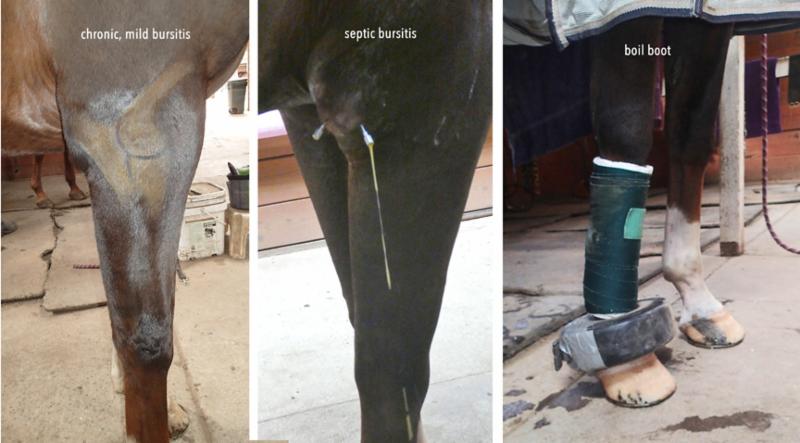The common terms “shoe boil or capped elbow” refer to inflammation of the olecranon bursa near the horse’s elbow. Several different bursae are found in the body. Their function is to help decrease friction between bone and soft tissues near a joint. Normally a bursa is a flat “potential space” with just enough synovial fluid inside to allow tissues to smoothly glide past each other. When a bursa becomes inflamed the condition is called bursitis. Inflammation causes thickening and increased fluid production within the tight space of the bursal sack which restricts the smooth movement of tissues over the affected area. Bursitis is typically caused by repeated trauma or pressure to, in this case, the area just below the point of the elbow. This repeated trauma may come from close contact between the horse’s hoof & shoe or other hard surfaces and the elbow while the horse is recumbent. It is less commonly caused by an acute injury such as a kick or a fall. Infection, or septic bursitis, may occur as a primary cause or it may develop secondarily to the initial inflammation.

The horse with olecranon bursitis presents with noticeable swelling located along the posterior (back) surface of the upper leg near the point of the elbow. (see photo) The amount of swelling often reflects the degree of inflammation and ranges from walnut sized and squishy to grapefruit sized, hard and hot. Ultrasound may be helpful to determine if a discreet fluid pocket is present. While it may be sensitive to the touch, the horse is generally not lame with non septic bursitis. Because of it’s location, the bursitis may be further aggravated by the girth rubbing against a swollen elbow.
Treatment of olecranon bursitis is directed at decreasing inflammation and removing the cause of the trauma. Hydrotherapy and fluid aspiration with or without steroid injection may be useful in cases that have not become chronic. Ultimately the primary goal is to keep the foot, shoe or hard surfaces from impacting the elbow when the horse lays down. A “boil boot”, a doughnut shaped boot that fits around the fetlock, can be used to help create space between the foot and the elbow when the horse is recumbent. Increasing bedding in the stall or turn out on pasture may also be helpful. In some situations tying the horse in a standing stall will allow the bursitis to resolve. Unfortunately, removing the cause of trauma is not always easy and this condition can become complicated by infection and/or become a recurring problem for some horses.
Elbow bursitis is relatively common in draft breeds and in gaited horses but it may be seen in a horse of any breed or occupation. In most cases it is problematic for cosmetic reasons, because of its location near the girth and because it tends to reoccur. Repeated episodes result in thickening from scar tissue that is subsequently more prone to re-injury. The condition is more serious if infection is involved because excessive tissue reaction may create a thick wall around the abscess pocket making it difficult for antibiotics to reach the area. Opening the abscess to allow drainage may become necessary, but carries with it the risk of slow healing and excessive scar formation. Significant tissue movement over the elbow joint when a horse lays down and stands up makes healing of any open wound here very difficult. Surgical removal of the scarred tissue and the bursa has been met with mixed results.
